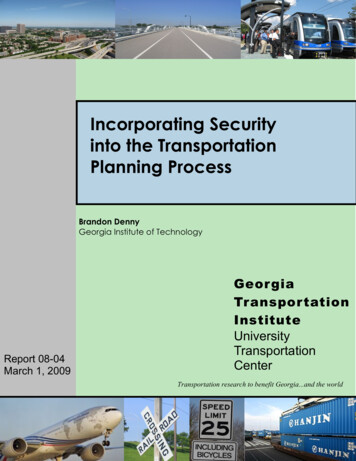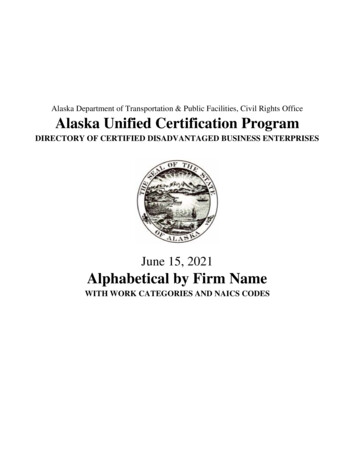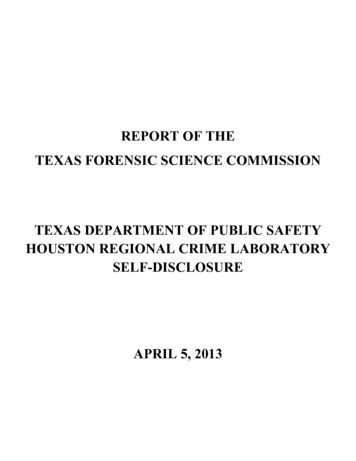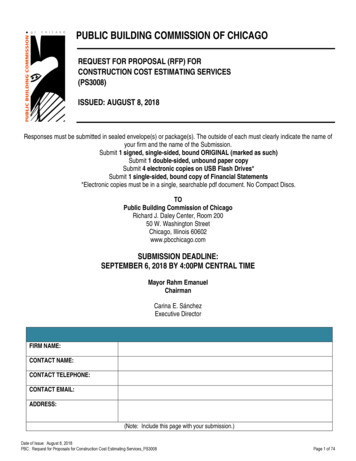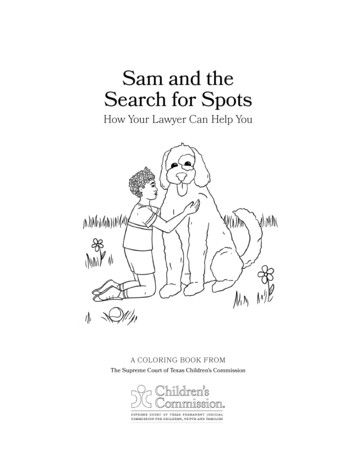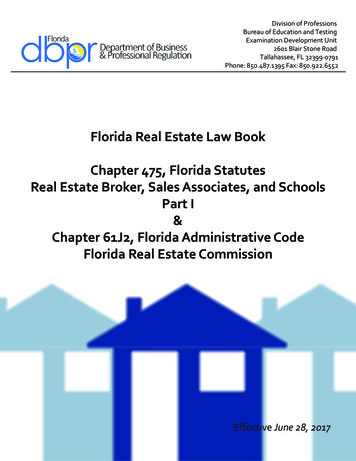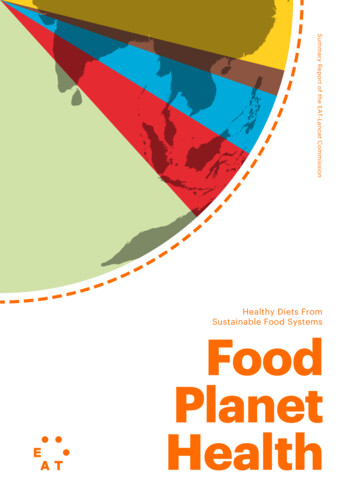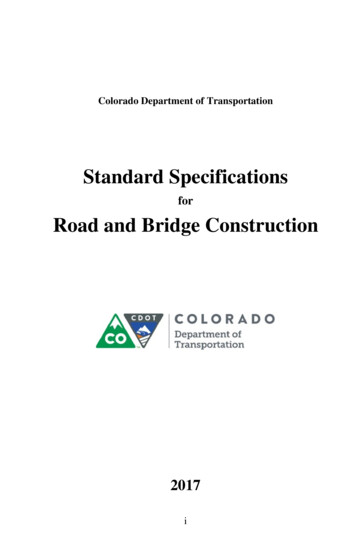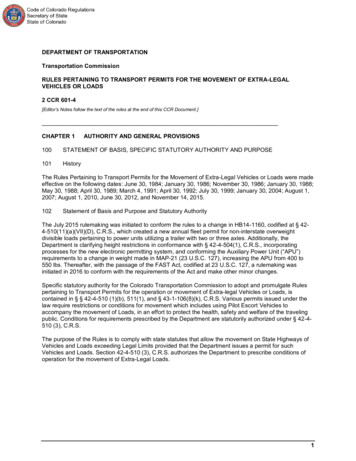
Transcription
loradoDEPARTMENT OF TRANSPORTATIONTransportation CommissionRULES PERTAINING TO TRANSPORT PERMITS FOR THE MOVEMENT OF EXTRA-LEGALVEHICLES OR LOADS2 CCR 601-4[Editor’s Notes follow the text of the rules at the end of this CCR Document.]CHAPTER 1AUTHORITY AND GENERAL PROVISIONS100STATEMENT OF BASIS, SPECIFIC STATUTORY AUTHORITY AND PURPOSE101HistoryThe Rules Pertaining to Transport Permits for the Movement of Extra-Legal Vehicles or Loads were madeeffective on the following dates: June 30, 1984; January 30, 1986; November 30, 1986; January 30, 1988;May 30, 1988; April 30, 1989; March 4, 1991; April 30, 1992; July 30, 1999; January 30, 2004; August 1,2007; August 1, 2010, June 30, 2012, and November 14, 2015.102Statement of Basis and Purpose and Statutory AuthorityThe July 2015 rulemaking was initiated to conform the rules to a change in HB14-1160, codified at § 424-510(11)(a)(VII)(D), C.R.S., which created a new annual fleet permit for non-interstate overweightdivisible loads pertaining to power units utilizing a trailer with two or three axles. Additionally, theDepartment is clarifying height restrictions in conformance with § 42-4-504(1), C.R.S., incorporatingprocesses for the new electronic permitting system, and conforming the Auxiliary Power Unit (“APU”)requirements to a change in weight made in MAP-21 (23 U.S.C. 127), increasing the APU from 400 to550 lbs. Thereafter, with the passage of the FAST Act, codified at 23 U.S.C. 127, a rulemaking wasinitiated in 2016 to conform with the requirements of the Act and make other minor changes.Specific statutory authority for the Colorado Transportation Commission to adopt and promulgate Rulespertaining to Transport Permits for the operation or movement of Extra-legal Vehicles or Loads, iscontained in § § 42-4-510 (1)(b), 511(1), and § 43-1-106(8)(k), C.R.S. Various permits issued under thelaw require restrictions or conditions for movement which includes using Pilot Escort Vehicles toaccompany the movement of Loads, in an effort to protect the health, safety and welfare of the travelingpublic. Conditions for requirements prescribed by the Department are statutorily authorized under § 42-4510 (3), C.R.S.The purpose of the Rules is to comply with state statutes that allow the movement on State Highways ofVehicles and Loads exceeding Legal Limits provided that the Department issues a permit for suchVehicles and Loads. Section 42-4-510 (3), C.R.S. authorizes the Department to prescribe conditions ofoperation for the movement of Extra-Legal Loads.1
CODE OF COLORADO REGULATIONSTransportation Commission1032 CCR 601-4General Provisions103.1An Extra-legal Vehicle or Load shall not operate or move on a State Highway, except bypermit as provided in the Rules. The Department may, upon submission of an applicationin writing, by facsimile, or by electronic means and Good Cause being shown therefore,issue a single-trip, a special, or an annual Transport Permit authorizing the Applicant tooperate or move an Extra-legal Vehicle or Load of a size or weight exceeding the LegalLimits established by or otherwise not in conformity with § 42-4-501 through §42-4-509,C.R.S. All permits shall be issued at the discretion of the Department, as provided in §424-510, C.R.S.103.1.1 All Extra-legal permits issued by the Department are valid for NondivisibleVehicles or Loads only, unless otherwise specified in this rule.103.1.2 As directed by § 42-4-504(1), C.R.S., the legal Vehicle Height limit of fourteenfeet six inches shall apply to Vehicles, unladen or with Load, on all Highwayswithin the Department’s jurisdiction. This legal Vehicle limit does not apply toVehicles travelling on Highways where there are overhead Highway structuresthat limit the vertical clearance to a lesser Height. The vertical clearances andlocations of said structures may be found ts.103.2In the permit, the Department may:103.2.1 Limit the number of trips or establish seasonal or other time limitations ofoperation;103.2.2 Limit or prescribe other conditions of operation when necessary to protect thesafety of Highway users, the efficient movement of traffic, or the State Highwaysfrom undue damage;103.2.3 Require security to compensate for any injury;103.2.4 Prescribe conditions necessary for the proper administration and enforcement ofthe extra-legal permit program.103.3The Permittee shall be responsible for compliance with:103.3.1 All terms and conditions in the Rules;103.3.2 All terms and conditions in the permit;103.3.3 All other applicable legal requirements, including the Commercial Vehicle Rules.103.4The Permittee shall be responsible for the safe movement of the Extra-legal Vehicle orLoad.103.5The Department will publish an electronic copy of the Rules on its website along with theBridge Weight Limit Map, the Pilot Escort and Oversize Restriction Map, and the HeightRestriction Map.CHAPTER 2200DEFINITIONSTerms used in the Rules shall have either their common sense meaning, or the meaning providedin §42-1-102, C.R.S., or the meaning provided below, as applicable.2
CODE OF COLORADO REGULATIONSTransportation Commission2 CCR 601-4201Applicant - An individual, firm, partnership, corporation, or association submitting an applicationfor a Transport Permit.202Auxiliary Power Unit (APU) - A portable, truck-mounted power system that can provide climatecontrol and power for trucks without idling.203Axle or Single-axle - All wheels, whose centers may be included within two parallel transversevertical planes not more than forty inches apart, extending across the full Width of the Vehicle.204Axle Group - An assemblage of two or more consecutive Axles that are considered to be togetherfor the purpose of determining their combined Load effect on a bridge or other Highway structure:204.1TANDEM AXLE - As defined in §42-4-507 (4) (b) C.R.S., A Tandem Axle is defined astwo or more consecutive Axles, the centers of which may be included between parallelvertical planes spaced more than forty inches and not more than ninety-six inches apart,extending across the full Width of the Vehicle.204.2TRIPLE AXLE - Any three consecutive axles whose extreme centers between any twoaxles within the grouping are not more than 96 inches apart and are individually attachedto or articulated from, or both, a common attachment to the vehicle including aconnecting mechanism designed to equalize the load between axles.204.3QUAD AXLE - Any four consecutive axles whose extreme centers between any two axleswithin the grouping are not more than 96 inches apart and are individually attached to orarticulated from, or both, a common attachment to the vehicle including a connectingmechanism designed to equalize the load between axles.205Booster Axle - An additional Axle used to distribute weight. Also referred to as a dolly, jeep, orstinger Axle.206Bridge Weight Limit Map - A map prepared by the Department indicating the Load posted bridgesand the allowable Axle weight for other bridges within the State Highway system. This mapdefines the maximum Axle and Gross Vehicle Weights authorized by the Rules. A copy of thismap may be obtained from the Department. This map illustrates all bridges within the StateHighway system in the following color coded manner to indicate allowable weight limits of Extralegal Vehicles or Loads on bridges:206.1Black - No overweight Vehicles or Loads allowed.206.2Orange - Major restrictions.206.3Yellow - Moderate restrictions.206.4White - Minimal restrictions.207Bulk Fluid Milk Products – A cargo tank shipment of raw unpasteurized milk from a dairy farm tomarket for processing.208Cluster Lights - An assemblage of three or more red or yellow clearance lights.209Commercial Vehicle Rules - The State of Colorado, Department of Public Safety, Rules andRegulations Concerning Minimum Standards for the Operation of Commercial Vehicles (8 C.C.R.1507-1).210Department - The Colorado Department of Transportation.3
CODE OF COLORADO REGULATIONSTransportation Commission2 CCR 601-4211Designated Highway Segments - Those highways as identified in 42-4-505 (3), C.R.S.212Divisible Load - A Vehicle or Load that can be divided into separate or different parts in less thaneight work hours or does not compromise the intended purpose of the Vehicle or Load or render itunable to perform the functions for which it was intended. See also “nondivisible load.”213Double Dolly Weight Chart - A weight chart used by the Department in conjunction with theBridge Weight Map in determining the maximum weight allowance for Vehicles with a doubledolly axle configuration or dual lane trailer.214Emergency - An imminent natural or man-made disaster including rising water, fire, unusualstorm, train wreck, flood, washout, and similar disasters affecting the general public's welfare.215Extra-legal Vehicle or Load - An overweight, overlength, overwidth or overheight Vehicle or Loadwhich exceeds the Legal Limits and for which the Department has granted a Transport Permit tooperate or move on State Highways.216Flashing Yellow Light - A warning lamp mounted as high as practicable, which shall be capable ofdisplaying a flashing, oscillating, or rotating yellow light with sufficient intensity to be visible at 500feet in normal sunlight.217Good Cause - A need to operate or move an Extra-legal Vehicle or Load on a State Highwaytogether with a showing that such operation or movement will not impair the safety of Highwayusers, the efficient movement of traffic, the integrity of the State Highway, or the administrationand enforcement of the Department's permit program, as determined from the permit applicationinformation.218Gross Vehicle Weight (GVW) - The total weight of a Vehicle or combination of Vehicles, includingany Load.219Height - The total vertical dimension of any Vehicle above the ground surface, including any Loadand Load-holding device thereon.220Height Restriction Map - A map prepared by the Department indicating the structures that have aminimum clearance of 16 feet or less. A copy of the map may be obtained from the Department.221Highway - As defined in §42-1-102 (43) C.R.S. The entire Width between the boundary lines ofevery way publicly maintained when any part thereof is open to the use of the public for purposesof vehicular travel or the entire Width of every way declared to be a public Highway by any law ofthis state.222Hours of Darkness - Sunset to sunrise.223Hours of Daylight - Sunrise to sunset.224Interstate Highways - As defined in Title 23 USC, Section 103.225Lane - As defined in §42-1-102 (46), C.R.S. That portion of a roadway used for the movement ofa single line of Vehicles.226Legal Limits - The size and weight limits for a Vehicle or Load, as defined in §42-4-502 through§42-4-509, C.R.S.227Length - The total longitudinal dimension of any Vehicle or combination of Vehicles, including anyLoad or Load-holding devices thereon.4
CODE OF COLORADO REGULATIONSTransportation Commission2 CCR 601-4228Load - A weight of commodity or equipment resting upon something else regarded as its support.229Local Authorities - As defined in §42-1-102 (48) C.R.S. Every county, municipal, and other localboard or body having authority to adopt local police regulations under the constitution and laws ofthis state.230Longer Vehicle Combination (LVC) - The Vehicle combinations defined in §42-4-505, C.R.S.231Longer Vehicle Combination (LVC) Permit. The permit granted by the Department authorizing theapproved carrier company to operate longer vehicle combinations (LVC) under these rules;hereinafter referred to as the permit. For the purpose of these rules the longer vehiclecombination permit will be an annual permit.232Maximum Limits - The maximum size and weight limits that may be allowed by Transport Permitfor an Extra-legal Vehicle or Load, as established in the Rules, the Pilot Escort and OversizeRestriction Map, the Height Restriction Map and the Bridge Weight Limit Map.233Manufactured Home. As defined in §24-32-3302 (20) C.R.S. “Manufactured home” means anypreconstructed building unit or combination of preconstructed building units that include electrical,mechanical, or plumbing services that are fabricated, formed, or assembled at a location otherthan the site of the completed home; is designed for residential occupancy in either temporary orpermanent locations; is constructed in compliance with the federal act, factory-built residentialrequirements, or mobile home standards; does not have motor power; and is not licensed as arecreational vehicle.234Mobile Machinery - As defined in §42-1-102 (54) C.R.S.235Mountainous Routes - Those routes designated by hash marks on the Pilot Escort and OversizeRestriction Map.236Nondivisible Load or Vehicle - Any Load or Vehicle exceeding applicable statutory size or weightlimits which, if separated into smaller Loads or Vehicles, would compromise the intended use ofthe Vehicle, for example, Make it unable to perform the function for which it was intended;Destroy the value of the Load or Vehicle, i.e., make it unusable for its intended purpose; orRequire more than 8 workhours to dismantle using appropriate equipment. The Applicant for aNondivisible Load permit has the burden of proof as to the number of workhours required todismantle the Load.Pursuant to federal regulations the State may treat emergency response vehicles, casksdesigned for the transport of spent nuclear materials, Bulk Fluid Milk Products, and militaryvehicles transporting marked military equipment or material as nondivisible vehicles or loads.237Non-Interstate Highways - As defined in §43-2-101 (1) C.R.S as the state highway system,except for those defined as the Interstate system in Title 23, U.S.C., Section 103.238Overhang (also known as Projection) - Any part of a Vehicle’s Load which projects beyond thefront most point of the grill assembly of the Vehicle engine compartment or beyond the rear mostfixed point of the transport Vehicle.239Permittee - An Applicant who has been granted a Transport Permit by the Department.5
CODE OF COLORADO REGULATIONSTransportation Commission2 CCR 601-4240Pilot Escort and Oversize Restriction Map - A map prepared by the Department indicating theState Highways where Pilot Escort Vehicles are required for the operation or movement of Extralegal Vehicles or Loads; the State Highways where oversize restrictions exist; and MountainousRoutes. This map defines the maximum Length and Width restrictions authorized by the Rules. Acopy of this map may be obtained from the Department.241Pilot Escort Certification Program - The training curriculum authorized by the Department andpresented by a Third Party Instructor or the Department.242Pilot Escort Vehicle - A motor Vehicle used for the express purpose as a warning Vehicle forExtra-Legal Vehicles or Loads and which meets the requirements of Chapter 5 of these rules.243Reference Point (RP) - Identifies a physical location on the Highway in relationship to thepreceding milepost markers.244Route Survey - A document detailing the specifics of the route, based on the vehicleconfiguration, dimensions, and weight, including but not limited to a detailed list of all overheadstructure clearances, bridge crossing posted weight limits, highway widths, and maneuverabilityconcerns. Route Surveys required due to Vehicle/Load dimensions other than Height shall bevalid for a period of thirty days unless otherwise determined by the Department.245Rules - Rules and Regulations Pertaining to Transport Permits for the Operation or Movement ofExtra-legal Vehicles or Loads, 2 C.C.R. 601-4.246Saddlemount Combination - A combination of vehicles in which a truck or truck tractor tows oneor more trucks or truck tractors, each connected by a saddle to the frame or fifth wheel of thevehicle in front of it. The saddle is a mechanism that connects the front axle of the towed vehicleto the frame or fifth wheel of the vehicle in front and functions like a fifth wheel kingpinconnection.247Self-propelled Fixed Load Crane - As stated in 42-4-510 (1)(c) (II), C.R.S., a self-powered mobilecrane designed with equipment or parts permanently attached to the body of the crane. A selfpropelled fixed load crane includes, without limitation, the crane's shackles, slings, andcounterweights. Cranes will be allowed to carry counterweights providing the vehicle does notexceed the Bridge Weight Limit map limits, and the counterweights are manufactured as part ofthe unit.248Semi-Trailer - Any wheeled vehicle, without motor power, designed to be used in conjunction witha laden or unladen truck tractor so that some part of its own weight and that of its cargo load restsupon or is carried by such laden or unladen truck tractor and that is generally and commonly usedto carry and transport property over the public highways.249State Highway (SH) - A Highway on the State Highway system, as defined in §43-2-101, C.R.S.250Transport Permit - A license granted by the Department to move or operate an Extra-legalVehicle or Load on a State Highway. The types of Transport Permits available are those permitslisted in Chapter 3 of these Rules.251Third Party Instructor - The entity or person authorized by the Department to conduct the PilotEscort Certification Program and certify students as authorized Colorado Pilot Escort operators.252Truck - As defined in §42-1-102 (108) C.R.S. Any motor Vehicle equipped with a body designedto carry property and which is generally and commonly used to carry and transport property.6
CODE OF COLORADO REGULATIONSTransportation Commission2 CCR 601-4253Truck Tractor - Any motor Vehicle which is generally and commonly designed and used to draw asemi-trailer and its cargo Load.254Unladen Expandable Dual-Lane Transport Trailer – An empty trailer capable of being expandedor reduced in Width.255Vehicle - A device, as defined in §42-1-102 (112), C.R.S. which is capable of moving itself, or ofbeing moved, from place to place upon wheels or endless tracks.256Width - The total outside transverse dimension of a Vehicle including the Load or Load-holdingdevices thereon and approved safety devices and tire bulge due to the Load, with the exceptionof rear view mirrors, clearance lights, or other accessories required by federal, state, or local lawsor regulations.CHAPTER 3300TRANSPORT PERMITS AND APPLICATION INFORMATIONThe following Permits are available:300.1Single Trip Permit: A permit that is valid for a single move not to exceed a maximum offive days, as determined by the Department, over designated State Highways for anExtra-legal Vehicle or Load.300.2Special Permit: A permit that is valid for only a single one-way trip over designated StateHighways for an Extra-legal Vehicle or Load that exceeds the Maximum Limits. Allspecial permits are subject to the provisions of Chapter 6 of the Rules.300.3Annual Permit: A permit that is valid for one year from the date of issuance on all StateHighways for an Extra-legal Vehicle or Load that does not exceed the Maximum Limits.300.4Annual Non-Interstate Permit: A permit that is valid for one year from the date of issuanceon all non-Interstate Highways for an Extra-legal Vehicle or Load that does not exceedthe legal size limits or the maximum weight limits per §42-4-510 (1) (b) (II) and the BridgeWeight Limit map.300.5Annual Fleet Permit: Overlength – A permit that is valid for one year from the date ofissuance on State Highways but only as authorized by §42-4-510 (11) (a) (II), C.R.S., foroverlength public utility Vehicles. Vehicles and/or Loads shall not exceed the MaximumLimits for Length as designated on the Pilot Escort and Oversize Restriction Map, and theRules.300.6Annual Fleet Permit: Overweight (LVC) Divisible – A permit that is valid for one year fromthe date of issuance for LVCs only, as authorized by §42-4-510 (11) (a) (III) (C), C.R.S.300.7Company Fleet Permit: A permit that is valid for one year from the date of issuance onState Highways but only as authorized by §42-4-510 (1.5), (2) and (11) (a) (V), C.R.S.,for Applicants with two or more Vehicles. Vehicles and/or Loads shall not exceed theMaximum Limits for Annual Permits as set forth in Chapter 3 of the Rules.300.8Non-Interstate Fleet Permit: A permit that is valid for one year from the date of issuancefor the use of Non-Interstate Highways as authorized in §42-4-510 (11) (a) (VI)(C) and(VII)(D), C.R.S. Vehicles and/or Loads shall not exceed the Maximum Limits for AnnualNon-Interstate Permits as set forth in Chapter 3 of the Rules.7
CODE OF COLORADO REGULATIONSTransportation Commission300.92 CCR 601-4LVC Overweight Vehicle Transport Permit: A permit issued to a Longer VehicleCombination, in possession of a Longer Vehicle Permit, which indicates the route oftravel, to haul in excess of legal weight on the designated route with a Divisible Load.300.10 Super Load: A sub-permit of a Chapter 6 Special for Vehicles and/or Loads as referencedin § 42-4-510 (1.7) (a) (I) and (II).300.11 6-Month Non-Interstate Divisible Load Permit: A permit that is valid for six months fromthe date of issuance on all Non-Interstate Highways for a power unit and a trailer that hastwo or three axles that does not exceed the legal size limits or the maximum weight limitsper § 42-4-510(1)(b)(II) (B), C.R.S., and the Bridge Weight Limit Map. This permit is validfor Divisible Loads (weight only).301Application Information.The Applicant must submit a completed application to obtain a Transport Permit in the manner prescribedby the Dept. Applications shall be submitted in person, by electronic means or by mail. Applications arenot accepted over the telephone.302When an Extra-legal Vehicle or Load is operating under any permit, an electronically transmittedcopy of a Transport Permit shall be acceptable.303The Applicant must include the following information and documentation as part of theapplication:303.1Applicant name, address and phone number.303.2Type of permit requested.303.3Method of payment.303.4Make, model and the entire Vehicle Identification Number of the power unit to bepermitted.303.5Start date for the Permit.303.6Maximum total weight of Extra-legal Vehicle or Load.303 7Distribution of axle weights with axle spacing if applying for overweight permit.303.8Maximum number of Axles of the complete unit.303.9Maximum Height of Extra-legal Vehicle or Load.303.10 Maximum Width of Extra-legal Vehicle or Load.303.11 Maximum Length of Extra-legal Vehicle or Load.303.12 Maximum front and/or rear Overhang of Extra-legal Vehicle or Load.303.13 Detail of shipment/cargo/load.303.14 Start and End point as origin and destination within Colorado.8
CODE OF COLORADO REGULATIONSTransportation Commission2 CCR 601-4303.15 Preferred Route(s) of Travel listed by highway numbers for all single trip permits andChapter 6 Special permits.303.16 Route Survey for all Vehicles or Loads that exceed 17’ 6” in height.303.17 Route Survey for all Vehicles or Loads that exceed 130’ in Length.303.18 USDOT number303.19 The Applicant’s signature on the paper application or by electronic means when using theonline application system.304ANNUAL PERMITS304.1Maximum Limits for Annual Permits - If an Extra-legal Vehicle or Load exceeds theMaximum Limits the Applicant must obtain a Chapter 6 Special permit. Chapter 6 Specialpermits will not be issued to Vehicles or Loads that are defined as a divisible Vehicle orLoad.304.2The Maximum Limits that may be authorized for an Extra-legal Vehicle or Load operatingunder an Annual Oversize/Overweight permit are as follows:304.2.1 Sixteen feet in Height, subject to the Maximum Limits for Height designated onthe Height Restriction Map.304.2.2 Two hundred thousand pounds Gross Vehicle Weight, subject to the MaximumLimits for Axle weight designated on the Bridge Weight Limit Map.304.2.3 Seventeen feet in Width, subject to the Maximum Limit for Width designated onthe Pilot Escort and Oversize Restriction Map.304.2.4 One hundred thirty feet in Length for all four-lane Highways.304.2.5 One hundred twenty feet in Length for all non-Mountainous, two-lane Highways.304.2.6 One hundred ten feet in Length for all Mountainous two-lane Highways.304.2.7 Thirty-five foot rear Overhang.304.2.8 Twenty-five foot front Overhang.305QUAD AXLE ANNUAL OVERWEIGHT PERMIT FOR DIVISIBLE VEHICLES OR LOADSThe Maximum Limits that may be authorized for an Extra-legal Vehicle or load operating under a QuadAxle Annual Overweight Permit for Divisible Vehicles or Loads are as follows:305.1Not to exceed fourteen feet six inches in Height, operating on a Highway, designated bythe Colorado Department of Transportation.305.2One hundred ten thousand pounds Gross Vehicle Weight, subject to the Maximum Limitsfor Axle weight designated on the Bridge Weight Limit Map. Vehicle must Be Configuredwith a Quad Axle grouping.305.3Eight feet, six inches in Width.9
CODE OF COLORADO REGULATIONSTransportation Commission305.42 CCR 601-4Length305.4.1 Tractor/Trailer Combination – Seventy feet in Length for all Highways. There isNo Length limit when trailer is fifty-seven feet four inches or less in Length whenutilized as a tractor/trailer combination.305.4.2 Truck/Trailer Combination – Truck shall not exceed forty-five feet in Length. Theoverall Truck/trailer combination shall not exceed seventy feet in Length.305.4.3 Single vehicle shall not exceed forty-five feet in Length.305.5306Legal front and rear Overhangs not exceeding four feet in front and ten feet in rear.TWO/THREE AXLE TRAILER ANNUAL OR 6-MONTH OVERWEIGHT PERMIT FOR DIVISIBLEVEHICLES OR LOADSThe Maximum Limits that may be authorized for an Extra-legal Vehicle or load operating under aTwo/Three Axle trailer Annual or 6-Month Overweight Permit for Divisible Vehicles or Loads are asfollows:306.1Not to exceed fourteen feet six inches in Height, operating on a Highway, designated bythe Colorado Department of Transportation.306.2Ninety-seven thousand pounds Gross Vehicle Weight, subject to the Maximum Limits forAxle weight designated on the Bridge Weight Limit Map. Vehicle configuration mustconsist of a power unit and a Trailer Configured with at least two but not more than threeAxles on the Trailer.306.3Eight feet, six inches in Width.306.4Length306.4.1 Tractor/Trailer Combination – Seventy feet in Length for all Highways. There isNo Length limit when trailer is fifty-seven feet four inches or less in Length whenutilized as a tractor/trailer combination.306.4.2 Truck/Trailer Combination – Truck shall not exceed forty-five feet in Length. Theoverall Truck/trailer combination shall not exceed seventy feet in Length.306.4.3 A Semi-Trailer used with a converter dolly shall be considered a trailer.306.5307Legal front and rear Overhangs not exceeding four feet in front and ten feet in rear.ANNUAL FLEET PERMITS FOR OVERLENGTH PUBLIC UTILITY VEHICLES OR LOADSThe Maximum Limits for operating under an Annual Fleet Permit for OverLength Public Utility Vehicles orLoads shall not exceed the following:307.1One hundred thirty feet in Length for all four-lane Highways.307.2One hundred twenty feet in Length for all non-Mountainous, two-lane Highways.307.3One hundred ten feet in Length for all Mountainous, two-lane Highways.10
CODE OF COLORADO REGULATIONSTransportation Commission3082 CCR 601-4ANNUAL FLEET PERMITS FOR OVERWEIGHT LVCSThe Maximum Limits for weight shall not exceed the legal Axle weight limits and the Gross VehicleWeight limits as described in Chapter 4 of the Rules.309Document Knowledge and Compliance Requirement.309.1A Permittee who has been issued an Annual Permit must:309.1Have the original Transport Permit or legible copy of the same in the permitted Vehicle,or have access to the Permit electronically, when operating or moving on and Highway inaccordance with § 42-4-510(4), C.R.S.309.2Be knowledgeable of, and comply with these Rules.309.3Route the Vehicle to comply with these Rules, the Bridge Weight Limit Map, the PilotEscort and Oversize Restriction Map, the Height Restriction Map and all Highwayrestrictions. This information is available on both the CDOT Commercial Vehicle PermitsWebpage or on the Motor Carriers’ dashboard of the CDOT permitting system by clickingon the Annual Permit Route link.310Permit Fees are established in §42-4-510 (11), C.R.S.311Company Fleet fees established in §42-4-510 (11), C.R.S. may be collected as follows:311.1A credit shall be granted for any unused portion of an Annual Permit on an individualVehicle when it is being added to a Company Fleet Permit. The credit shall be calculatedby the Department on a quarterly basis and shall not exceed the total base cost of theCompany Fleet Permit.311.2For new Vehicles added to a Company Fleet Permit during the course of the permit term,the fee of three hundred dollars ( 300.00) shall be prorated calculated on a quarterlybasis for the remainder of the effective period of the Company Fleet Permit.CHAPTER 4400TRANSPORT PERMIT OPERATING REQUIREMENTS AND RESTRICTIONSEXEMPTIONS TO HOURS OF RESTRICTION:The following Vehicles and/or Loads although still subject to permit requirements are not subject to thehours of restriction:401400.1Overweight Vehicles, not in excess of 110,000 pounds Gross Vehicle Weight, not inexcess of any other legal limit and capable of maintaining a minimum speed of 40 mphon a flat grade, 30 mph on a grade or the minimum posted speed limit (if lower), or400.2Vehicles and or Loads responding to Emergencies as defined in 214 of the Rules.Regional Hours of Restrictions401.1DENVER AREA CURFEWSAn Extra-legal Vehicle or Load is prohibited from travel, at the following times, unless authorizedunder a Chapter 6 Special or Super Load Transport Permit in the Denver Area, during the hoursof 6:00 a.m. to 9:00 a.m. and 3:00 p.m. to 6:00 p.m., Monday through Friday, on the followingsegments:11
CODE OF COLORADO REGULATIONSTransportation Commission2 CCR 601-4401.1.1 I-25 betwe
224 Interstate Highways - As defined in Title 23 USC, Section 103. 225 Lane - As defined in §42-1-102 (46), C.R.S. That portion of a roadway used for the movement of a single line of Vehicles. . CODE OF COLORADO REGULATIONS 2 CCR 601-4 Transportation Commission 5 228 Load - A weight of commodity or equipment resting upon something else .

